Wireless Transparent Bridging With WDS
WDS(Wireless Distribution System) is a means to transparently bridge wireless APs. What exactly does transparent bridging mean? A transparent bridge is basically turning your wireless links into an ethernet cable. It takes anything put into one side and spits it out on the other.
This is great for connecting two locations. This is often used for towers that utilize a router in the center that does PPPoE aggregation with separate radios to bring in clients. Another note is that WDS implementations doesn’t span vendors. Vendors use their own proprietary versions.
Generally you run one side as an AP with WDS and the other side as a station WDS client. You can generally connect two APs running WDS, but this is usually unnecessary.
Mikrotik
In Mikrotik we have to create a bridge interface. We then add our desired ethernet interfaces to the bridge. Once the radios connect a WDS interface is automatically created and added to our bridge. This will connect the ethernet interfaces across the wireless via layer 2.
AP Radio
Station Radio
Ubiquiti
In ubiquiti we don’t have to go through the trouble of creating bridges and such, we just make sure to leave the network mode in its default bridge mode and then configuring the wireless interfaces as follows.
AP Radio

If you like this article you can leave me a comment…if you hate it blame Tim Payne cause it was his idea…hehehehe


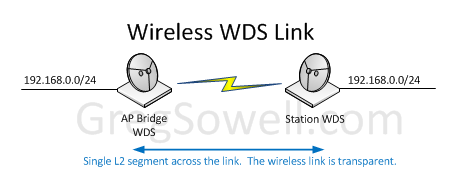

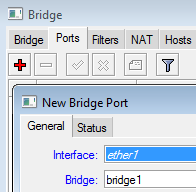

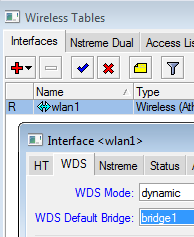
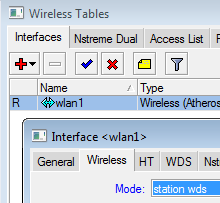
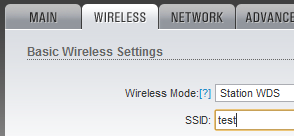
WDS is the way to go for sure
It is the breakfast of champions. You can alternately do EOIP tunnels or VPLS, but it adds overhead and complexity.
I’ve read that you take a performance hit with WDS due to the implementation inherent in 802.11. What is your take on that?
We’ve been doing MPLS/VPLS bridges. It’s been working out good so far but it is more complex. We have had some issue with the wireless link coming back but the VPLS tunnel not reestablishing itself. Could not get the tunnel back so I rebooted both devices and it worked after that. Any idea how to resolve that in the future without reboots?
One thing I’ve noticed in testing Mikrotik versus Ubiquiti gear is that even in WDS mode, the Ubiquiti gear has problems with multicast traffic.
I was testing sending just 2mbit of multicast video over a wireless link to a station with a STB prototype and consistently with Ubiquiti gear I was getting dropouts.
Rocket M2 NanoStation M2 and NSM2 NSM2 both, in WDS and non-WDS modes, Airmax on and off, etc… 5.2.1 and current stable 5.3 branch softwares…
None of them worked properly.
Then, for grins, I setup a Mikrotik SXT in WDS mode and it works beautifully. Not a single dropout at several multicast streams up to and passing 10mbit. Even when the Unicast traffic is running several dozen mbit at the same time.
@Robert
I’ve heard of issues with UBNT and multicast…specifically how it pac-mans OSPF multicast traffic. I was under the impression that this was rectified, though from your reports they are still working out the kinks. I have yet to test any of the SXT stuff…I’ve not had any distributors crazy enough to send me review samples…hehe.
Perhaps JJ can chime in…he constantly has his UBNT gear in flux testing.
@Justin
You may take a small hit, but that is a small price to pay. If your getting 75Mb full duplex on your link and your internet connection back at the border is only 45Mb, then you won’t really notice the performace hit 🙂
Airmax radios do have issues with OSPF. 5.3 seems to have fixed the issues I have bee seeing. Before that I was running EOIP tunnels and running OSPF across them.
@Justin
The best way to work around the issue is to disable OSPF’s default behavior of using multicast and switching it to unicast. Under the OSPF interface, set the type to NBMA (nonbroadcast multi access). You then set all of the peers in the neighbor table. This will cause the router to send all communications unicast, thus bypassing the multicast issues.
Will this work in a point-to-multi-point configuration? For example, using Mikrotik, could there be one radio set to “AP Bridge” and two radios in different locations set to “station WDS”? This would simply a very small customer network if it would work. Thanks in advance.
@Jim
This will indeed work point to multi-point.
@greg our border is 200 mbit with a sprawling backhaul that spans 7 links long, ~15 miles, and over 30 building. The further away a building is from our border, the more important it is for each link to be at peak operation.
We’ve got about 8 or 9 SXT’s out in the field and they are good for less then 1 mile links in an urban environment.
We have some UBNT gear but swapped it out for MT. Best to be standardized. UBNT also reboots way too much.
@Justin
I assume you are doing Nv2 on your SXT links?
Yeah, NV2 with mpls/vpls. Dual pol N. 20Mhz ch w/ control. Between radio interfaces we can do 196 Mbps UDP in lab. We have deployed links doing 130 Mbps UDP test. (SXT to Dual Pol Sector)
@Justin
UDP is dead to me! It in no way reflects realistic traffic, but is fun to see. It sure will max out a link, though.